Table of Contents
The one thing about a mill laboratory which is very similar to the college laboratory is the desk or laboratory workbench for general operations which is present in one form or another in every laboratory. If the desk is to be placed in the middle of the room, it is usually a double desk; if against the sides of the wall, it is, of course, a single desk. The size will vary to suit the space which it is to occupy. Particularly is this true with respect to length. With regard to its width, the latitude is, of course, not so great. Nothing is gained by having a single desk over three feet wide, or a double desk over six feet wide; nor would it be advisable to make a double desk less than forty- five inches wide. The height from the floor may vary with the ideas of the user; the usual height, however, is from 34 to 38 inches. The writer has found 36 inches a good height. The general work-bench is usually made with closets and drawers. Some desks are made with the drawer part projecting beyond the closets. This has the advantage of making the closet less deep and consequently allowing several shelves to be put in the latter.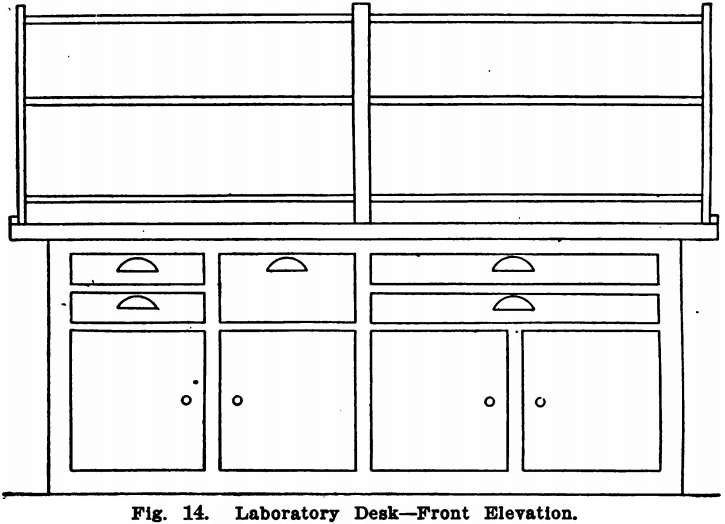
Figures 14 and 15 show a desk such as the writer has generally used, which is modeled somewhat after those with which most students are familiar in the college laboratories, and Fig. 16 shows this same desk with the drawer part projecting beyond the closets. Its dimensions, in this particular case, are 7 feet, by 5 feet and it is 36 inches in height. It has five drawers on each side—two narrow drawers for watch glasses, filter papers, evaporating dishes and such flat apparatus; one deep drawer for large,
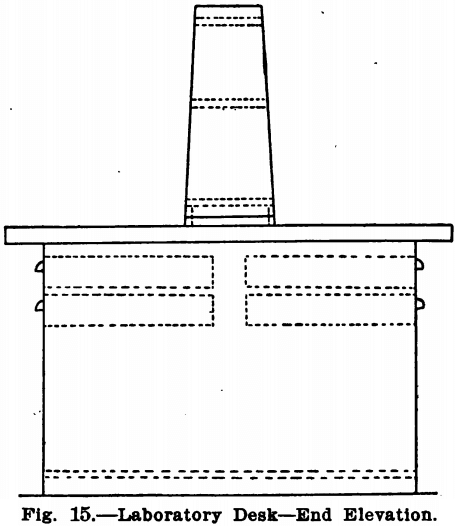
bulky articles; and two wide shallow drawers for burettes, glass tubing, and long flat articles. If the desk is desired longer than this, it can, of course, be lengthened by the addition of another set of drawers and cupboards.
Laboratory Workbench Drawers
There is usually more or less inconvenience in pulling drawers in and out, from their binding on the sides. This is particularly annoying when the drawer is full of glassware, as breakage is likely to occur from the sudden jar used to force is in or pull it out. Figure 17 shows an arrangement which will prevent this. It consists in fastening a narrow strip of well- seasoned board, B, along the bottom of the drawer, A, and fastening to the frame of the desk two other narrow strips, C’, C” one on each side of the strip on the drawer. These two strips form a groove in which the other one runs and in this way the drawer is always kept in the proper position to slide in and out easily.
The drawers can be cut up into partitions for different sizes of watch glasses, filter papers, evaporating dishes, etc. If no safe is at hand in which to store the platinum, one of the top drawers of the bench may be provided with a lock and key and used for this purpose. In this case, instead of an ordinary bottom it should
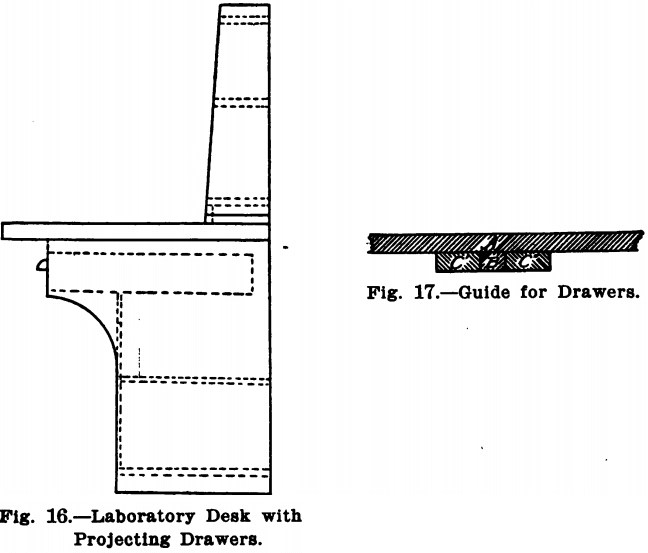
have a piece of two-inch board fitted in. In this are to be bored holes which exactly fit the various crucibles, dishes, etc., in use in the laboratory. The holes for the crucibles need not be gouged out just to fit the crucibles but may be bored with brace and bit of such size that the crucible will fit in them snugly. Alongside of the hole for the crucible should be cut a narrow deep slot for its lid. This is a very satisfactory way of keeping platinum, as each crucible has its place and can not roll around in the drawer, thereby getting out of shape.
In the drawers designed for such apparatus as U-tubes CaCl2 tubes, etc., it will be well to have rows of pegs about three or four inches apart, and 1½ to 2 inches high; the tubes, etc., can then be laid in among these in such a way as to keep them from rattling around every time the drawer is opened, thereby preventing breakage.
Laboratory Desk Cupboards
The floor of the cupboard should be three inches above the floor of the laboratory to prevent dust, etc., being swept into the former. Shelves can, of course, be added if desired. In the desk shown in Fig. 15 there is a shelf midway between the floor and the cupboard. In a desk made as deep as this, one shelf is all that can well be added. In a narrower desk, several shelves can be added, as it is not necessary to reach back so far for the apparatus. Instead of having the doors of this cupboard arranged to open outward, as they are in the cut, they can be fixed to slide by each other in grooves.
Laboratory Workbench Shelves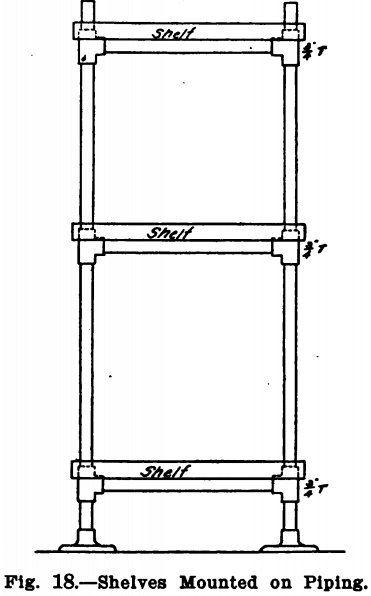
The reagent shelf should be at least six inches wide for the single desk and about ten to fourteen for the double desk. A six-inch shelf will hold a five-pound reagent bottle or a five-pint acid bottle. If wished, the bottom shelf may be six or eight inches wide, and the next an inch or so less. If gas is on the table, the bottom shelf may be raised a little above the desk and the space between the two filled in to make a sort of stop, as shown in Fig. 15, so that Bunsen burners cannot be carelessly pushed under the shelves and set them on fire. In most commercial laboratories where special tables can be provided for each operation, gas may not be needed on the general work table. If desired, however, it can be run either along the front of the table just above the drawers, or along the back of the first reagent shelf; or this shelf may be raised six inches from the table and the gas pipe run under it.
If it is desired to set five-pint acid bottles on the shelf, it must be at least 14 inches from the one above it. Nothing is gained by running the reagent shelves higher than can be reached by the operator standing on the floor. The double desk should have a rail running lengthwise down the middle of each shelf, except possibly the top, to prevent things put on one side from shoving things off on the other.
Fig. 18 shows a convenient way of mounting shelves with iron pipes. The construction is evident from the illustration and all parts are regular stock pipe fitting. It is sometimes convenient to hang shelves from the ceiling so as to leave the whole surface of the table free. If this is done, the above way of using pipe is convenient. These hanging shelves are usually made quite wide and do not come nearer to the top of the table than to 3 feet. It is sometimes found more convenient to bring gas down from the ceiling to the single or double tables—running down one pipe on each side of the reagent shelves and terminating each in a double jet. The table may, of course, be provided with water supply and waste pipes and suction if thought necessary. The water may be brought down from the ceiling also, just as the gas is.
Reagent Bottles Storage
A neat form of glass stoppered reagent bottle for this table is that with flat hood shaped stopper. A still better form is one devised by Prof. Jewett, of Oberlin College (see Fig. 19), manufactured for E. H. Sargent & Co., Chicago, III. In this bottle, the mouth and lip are completely protected from dust by the hood stopper and its pendant flange, made in one piece. 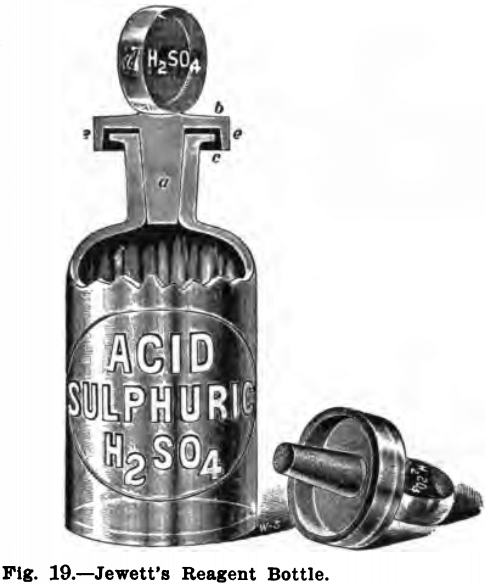 This helps to keep the contents of the bottle pure. These bottles have chemical names and symbols in raised letters with ground surfaces, made in 4 and 8-oz. sizes. One of the best forms of label which the author has seen is that which Whitall, Tatum & Co., of Philadelphia and New York, have introduced. This is a label of vitrified glass in which the label itself presents a smooth white glass background, against which the transparent letters and symbols show distinctly. This label is more legible than the ordinary raised letter with the ground glass face.
This helps to keep the contents of the bottle pure. These bottles have chemical names and symbols in raised letters with ground surfaces, made in 4 and 8-oz. sizes. One of the best forms of label which the author has seen is that which Whitall, Tatum & Co., of Philadelphia and New York, have introduced. This is a label of vitrified glass in which the label itself presents a smooth white glass background, against which the transparent letters and symbols show distinctly. This label is more legible than the ordinary raised letter with the ground glass face.
